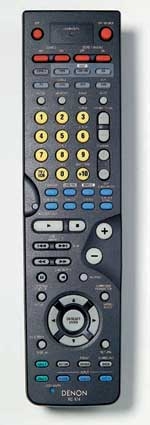Denon AVR-2805 Digital Surround Receiver Page 2
|
Nevertheless, if you asked Denon to name the receiver's most notable feature, it would probably be the auto-setup routines. The AVR-2805 joins the growing ranks of A/V receivers that come with small calibration microphones. You hook up the microphone, place it at your listening position, and select auto-setup from the onscreen menu. After a series of noise bursts from each channel in turn, your parameters are set for speaker size and distance, bass crossover, and channel levels. I found the AVR-2805's settings just about perfect all around.
The Denon can even use its supplied microphone and onboard smarts to automatically perform "room equalization," boosting or cutting the level in eight bands per channel, with freely variable center frequencies and "Q" (bandwidth) for each band, as with a parametric equalizer. There's also a manual mode that's more like a graphic equalizer, with level adjustments in eight fixed, 1-octave bands per channel.
Experimenting with the auto-EQ modes was fascinating. The corrections were larger than I expected, and when I moved the microphone 18 inches to the left and repeated the process, the results differed in all parameters (frequency, Q, and level) for almost every band in every channel. This confirms that without extensive spatial averaging, even the most sophisticated room equalization can work only for a single, fairly rigid listening position. (For proof, move your head by as little as a foot in any direction in your room. What you hear is likely to change.) While one of Denon's three auto-EQ presets might prove useful in some rooms, I did most of my listening with the system off.
 OPERATION On the ease-of-use front, the Denon produced few surprises. I found its onscreen menus simple and logical. I especially liked that there's a single screen for all the important surround parameters and another for temporary tweaking of channel levels and front-rear balance.
OPERATION On the ease-of-use front, the Denon produced few surprises. I found its onscreen menus simple and logical. I especially liked that there's a single screen for all the important surround parameters and another for temporary tweaking of channel levels and front-rear balance.
The supplied multicomponent learning/preprogrammed remote has a reasonably good layout, but the lack of backlighting or other illumination earns a demerit in this price range, especially given its small white-on-black control labels. The code library is adequate but not as inclusive as some - it had no codes for my TiVo/DVD recorder or my HDTV, both current models from major brands.
MOVIE PERFORMANCE The AVR-2805 cleared a selection of my regular movie-sound hurdles without breaking a sweat - things like the train crash from The Fugitive and the buffalo stampede in Dances with Wolves with complex, dynamic sound in all six main channels at once, stressing amplifier reserves and digital surround processing simultaneously. But the Denon excelled just as audibly on subtle stuff as well.














































